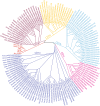Mammalian CD1 and MR1 genes
- PMID: 27470004
- PMCID: PMC5002277
- DOI: 10.1007/s00251-016-0926-x
Mammalian CD1 and MR1 genes
Abstract
All higher vertebrates share the fundamental components of the adaptive immune system: the B cell receptor, the T cell receptor, and classical MHC proteins. At a more detailed level, their immune systems vary considerably, especially with respect to the non-polymorphic MHC class I-like proteins. In mammals, the CD1 family of lipid-presenting proteins is encoded by clusters of genes of widely divergent sizes and compositions. Another MHC class I-like protein, MR1, is typically encoded by a single gene that is highly conserved among species. Based on mammalian genomes and the available data on cellular expression profiles and protein structure, we review MR1 genes and families of CD1 genes in modern mammals from a genetic and functional perspective. Understanding the CD1 and MR1 systems across animal species provides insights into the specialized functions of the five types of CD1 proteins and facilitates careful consideration of animal models for human diseases in which immune responses to lipids and bacterial metabolites play a role.
Keywords: CD1; Lipid antigens; MR1; Mammals.
Figures

References
-
- Angenieux C, Fraisier V, Maitre B, Racine V, van der Wel N, Fricker D, Proamer F, Sachse M, Cazenave JP, Peters P, Goud B, Hanau D, Sibarita JB, Salamero J, de la Salle H. The cellular pathway of CD1e in immature and maturing dendritic cells. Traffic. 2005;6:286–302. doi: 10.1111/j.1600-0854.2005.00272.x. - DOI - PubMed
Publication types
MeSH terms
Substances
LinkOut - more resources
Full Text Sources
Other Literature Sources
Research Materials

